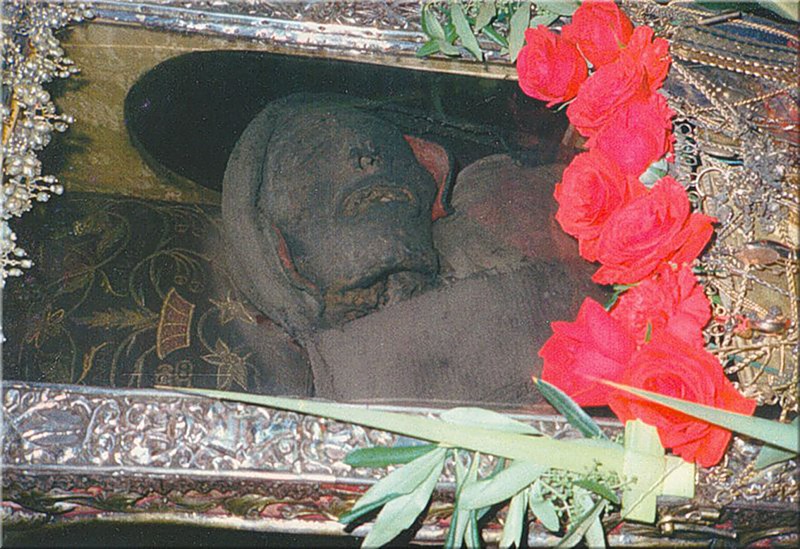
Saint Spyridon reposed in the Lord in the year 348 in his native Cyprus. It was observed soon after that his revered relics remained incorrupt and became a source of many miracles, to the glory of God. For three hundred years after his repose, his sacred relics remained in Cyprus, and in the seventh century, according to his biographer Bishop Theodore of Paphos in 655, they were placed in a church in Trimythous of Cyprus.
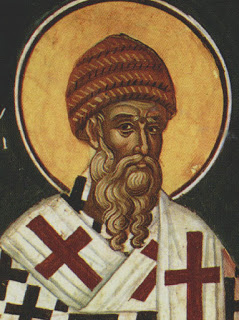
Due to the Arabic raids on Cyprus, the sacred relics of Saint Spyridon were transferred to Constantinople at the end of the seventh century, probably in the year 691 by order of Emperor Justinian II (685-695, 705–711). In Constantinople the relics were kept in a female monastery, according to testimony from a twelfth century manuscript (Cod. Paris. Gr. 1594), next to the male Monastery of Christ Philanthropos, probably in the Convent of the Panagia Kecharitomene, which were both founded in the eleventh century by Irene Dukas, wife of Emperor Alexios I Komnenos (1081–1118), and
were separated by a wall.
The Russian traveler Anthony of Novgorod records in 1200 that he saw the relics of Saint Spyridon below the altar of the church in the Monastery of the Most Holy Theotokos the Odegetria. It then appears that the venerable relics of the Saint were brought to the grand Church of the Holy Apostles, which was founded by Emperor Justinian I around 550 A.D. and was second in grandeur only to that of Hagia Sophia. Stephen of Novgorod (1350), Ignatius of Smolensk (1389-1405) and the writer Alexander (1393) say that they venerated the relics of Saint Spyridon in the side chapel of the Church of the Holy Apostles, while Deacon Zosimas (1419-1421) confirms that “in this church (of the Holy Apostles) the great Spyridon rests.”
A few months prior to the fall of Constantinople to the Turks, on December 12th of 1452, a festive Liturgy was celebrated in the Church of Hagia Sophia to celebrate the union of the Orthodox and the Papists, and the sacred relics of Saint Spyridon were processed amidst much pomp in honor of his feast.
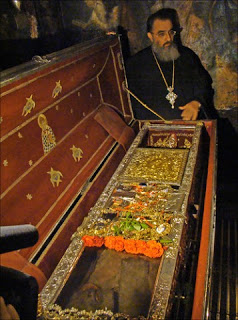
The sacred relic of Saint Spyridon was said to have been brought to Kerkyra in 1456. Initially it was believed that the Priest George Kalohairetis brought the relics of Saint Spyridon and Saint Theodora (Feb. 11) to Kerkyra by enclosing them in two sacks filled with straw, after traveling through Greece on a donkey without incident. This opinion was recorded by Nicholas Voulgaris and first published in Venice in 1669 (Vera relatione del thaumaturgo etc. Venetia MDCLXIX), and he based this on the various writings of his family. But Bishop Methodios of Kerkyra and Paxos discovered in 1808 a manuscript from the fifteenth century that told another story, which was published in Greek in the Service of Praise and the Life of Saint Spyridon and placed as a footnote in The Great Synaxarion. Bishop Methodios says:
“The sacred relics of Saint Spyridon were not transferred to Kerkyra by the Priest George Kalohairetis, but by decree of the duke of the Council of the Ten Democracies of Venice. The transfer out of Constantinople took place on the 14th day of May, in the year 1489. The relics were brought to Paramythian, Epirus where they stayed for a time. The Priest Gregory Polyefktos who was there, in 1496, then brought the relics to Kerkyra. Once on the island, he found them and gave them to the Priest George Kalohairetis. Father George’s son, Luke, then was bequeathed the relics, which he passed on to his neice, Asemine, the daughter of Philip, who was also Father George’s son. Supposedly it was given to her as part of her dowry when she married Stamatios Voulgaris. In a document dated the 25th day of November, in the year 1571, the sacred relics were deposed of by will to her sons and descendents.”
In 1489 Philip Kalohairetis tried to bring the sacred relics of Saint Spyridon to Venice, but this did not take place and it remained in Kerkyra.
It should be noted that separate from the incorrupt body of Saint Spyridon is the incorrupt right hand of Saint Spyridon, also in Kerkyra. It is not known how or when the right hand of Saint Spyridon became separated from the rest of the body. According to a testimony, the arm was brought to Rome straight from Constantinople some time between 1592 and 1605, over a century after the body of the Saint was brought to Kerkyra. In the seventeenth century the relics of Saint Spyridon were seen in Kerkyra without the right hand. This was because it was in Rome in the Church of Santa Maria in Vallicella, to which it was given by Pope Clement VIII to Cardinal Cesare Baronio of the Oratory of Saint Philip Neri. There it remained until 1986 when the right arm of Saint Spyridon was brought back to Kerkyra, with great celebration.
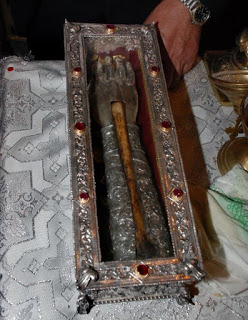
The Great Synaxarion also footnotes that, at the beginning, the relics of Saint Spyridon were placed in the Church of Saint Athanasios, which was later pulled down by the French in 1808. Then, together with those of Saint Theodora, the relics were removed to the Church of Saint Lazarus, near the San Rocco. Later the relics of Saint Spyridon were transferred to the Church of the Archangel Michael in 1589, while those of Saint Theodora were situated in Saint Nicholas, where her relics remained until 1740, when they were then brought to the parish Church of the Archangel Michael. In 1841, when the Church of the Most Holy Theotokos Speliotissa was rebuilt and designated as a Cathedral, her relics were transferred therein, and they remain there until today.
Stamatios Voulgaris, two years after his marriage (1527), received permission from Nicholas Vragadino, an official, to build his own church to Saint Spyridon, near the Church of Saint Lazarus. After long judicial wrangling, the relics were transferred to the new church from that dedicated to the Archangel. In 1537, upon the attack of Sultan Suleyman, the relics were temporarily moved to the Chapel of Saint Kosmas and Damian in the old fort, where the Voulgaris family fled. In 1557, Artemios and Nicholas Voulgaris were compelled to bring the relics and the vessels of the Church of Saint Spyridon to the Church of Saint Nicholas in the suburb of Garitse, since the Venetians were leveling that area in order to fortify the city. In connection with this exchange, another church was raised up, consecrated in 1589, and completed in 1594, at which time the relics were deposited therein, and they remain there until today.
The reliquary is opened for general veneration in the church for three days during the feast of Saint Spyridon, that is, from the 11th to the 13th of December; then four days during the paschal season from Great Saturday to Bright Tuesday. All the Christians zealously gather together, hastening day and night while a vigil is conducted. During the Great Fast, every Great Saturday is distinguished to commemorate the arrival of a wheat-laden vessel in days of old, when the population was saved by divine providence from a universal famine.
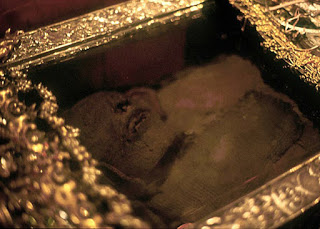
It should be noted that there is a procession (liti) with the sacred relics of Saint Spyridon in Kerkyra four times a year. They celebrate events in which the Saint saved the people and the island. The most elegant and lengthy of all processions is the one that circles the entire city once. It is conducted on Palm Sunday on the occasion of the epidemic which struck in 1630. Another procession is also scheduled for the first Sunday in November, and was instituted in 1673 by the Venetians, due to a plague that swept the island that year. Another important procession is held on the 11th of August, in memory of the liberation of the island from the Turkish invasion in 1716.
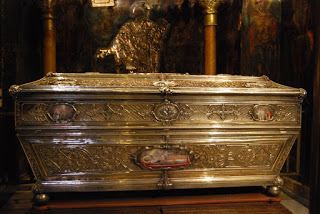
Up until the year 1605, during processions, the relics were completely uncovered, borne in the arms of a single priest. This practice, however, was considered improper. Therefore, a silver reliquary was constructed in Venice, and gilded and partially covered with crystal, at the expense of Thomas Motsanega; in this the relics were placed. The case itself was then placed within a larger silver reliquary. During the processions, which are conducted with great splendor, the reliquary is borne about by the priest. In Venetian times, they were attended by all the civil authorities, often with the Latin bishop carrying candles. In days of old, two of the priests who carried the reliquary belonged to the Voulgaris family (who helped build the church), and two were members of the monastic order of Saint Basil (to which the Saint supposedly belonged). The magnificent order of the processions lasted into the period of the French and English rule and until Kerkyra was united with Greece.

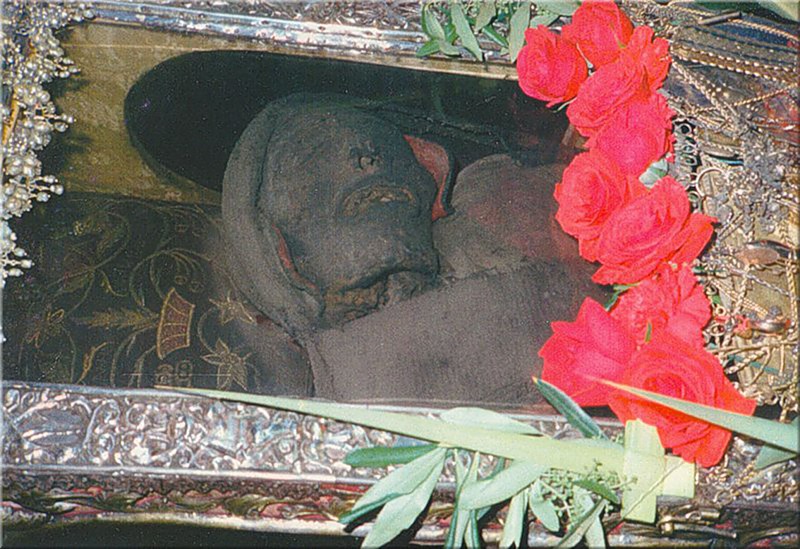


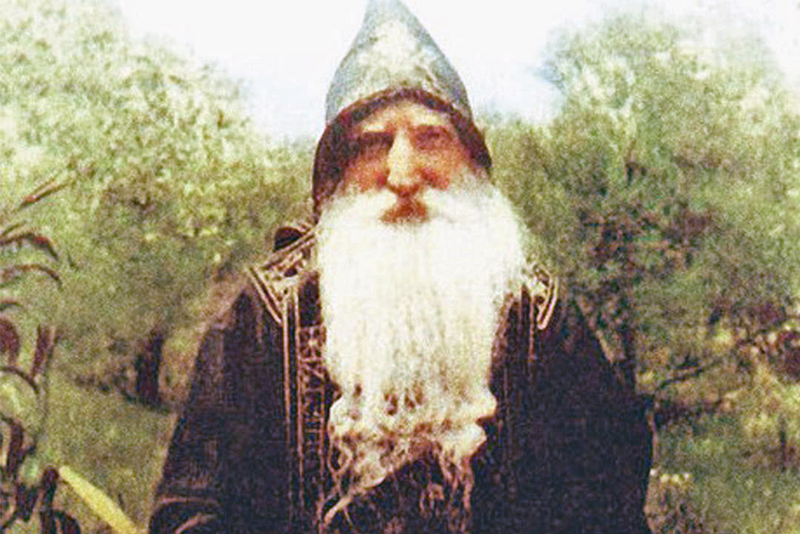
Благословите
Возможно ли читать все эти интересные статьи на русском языке?